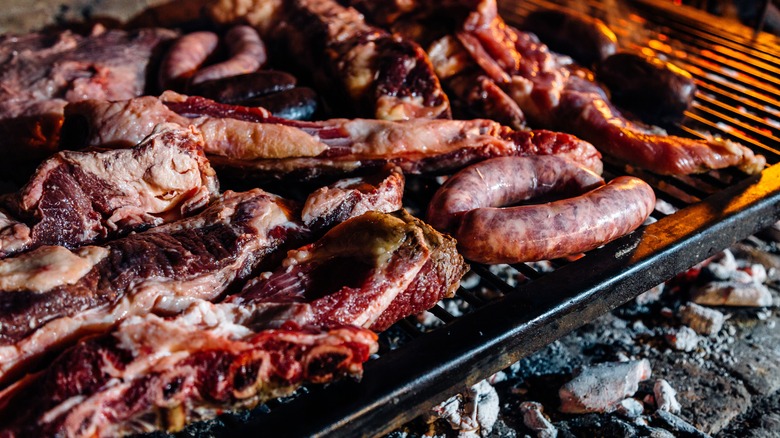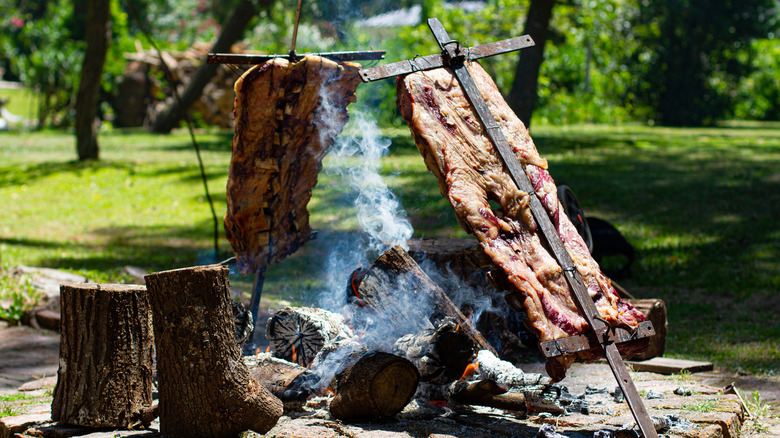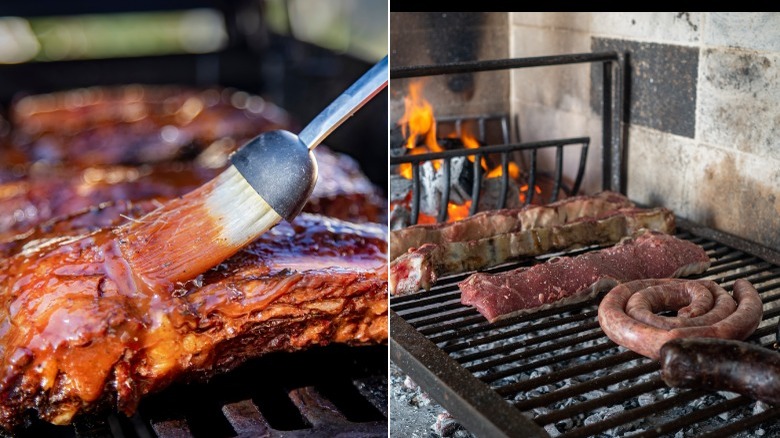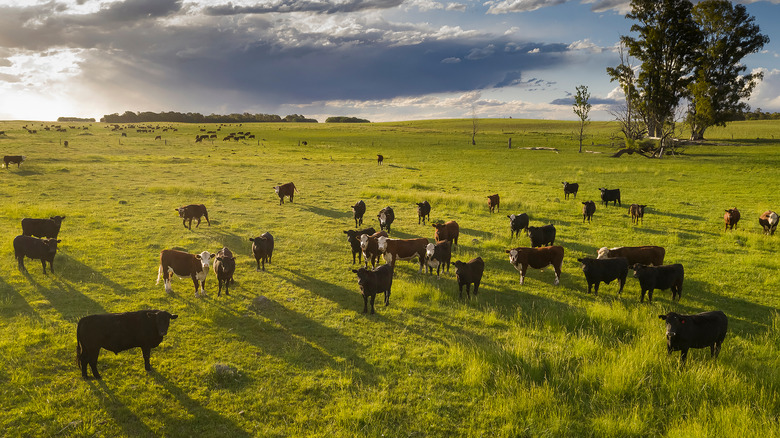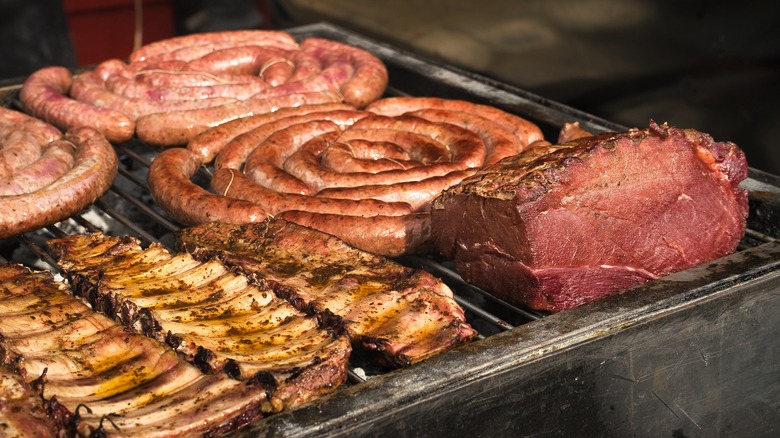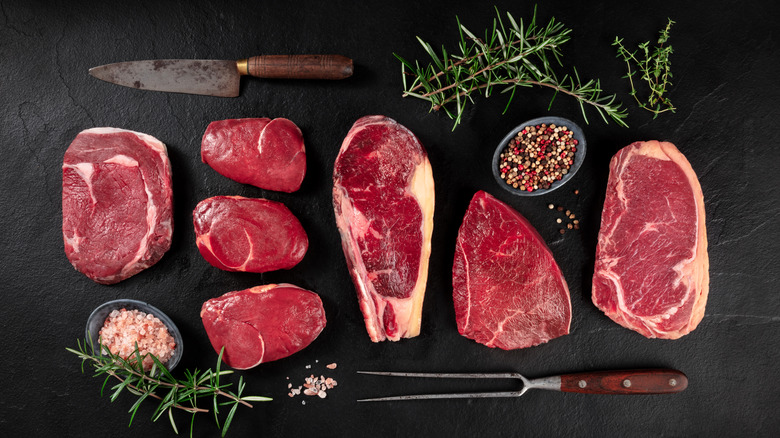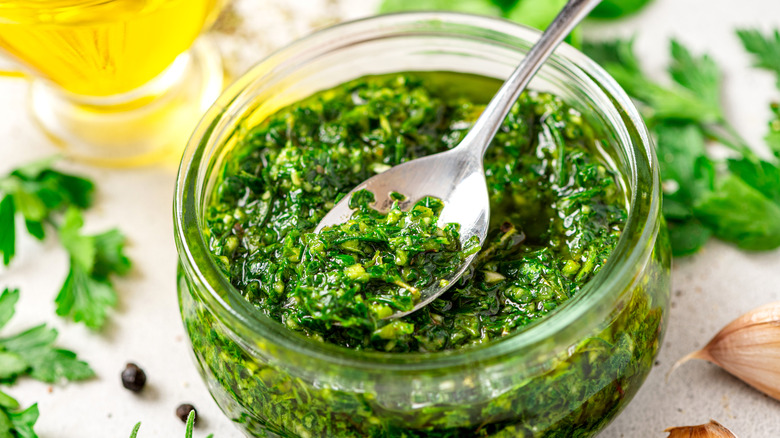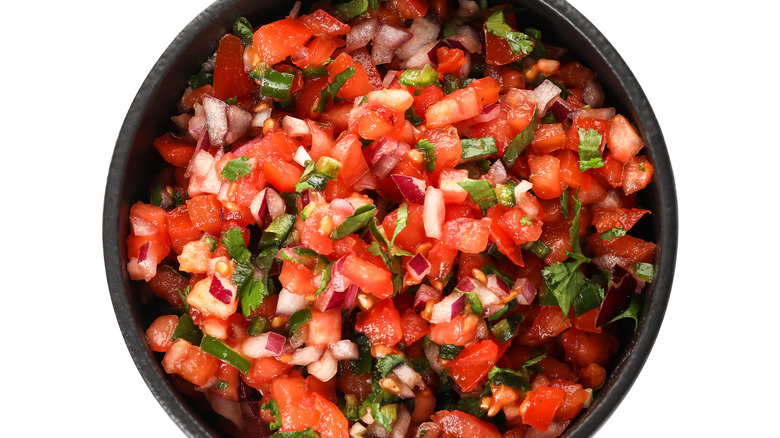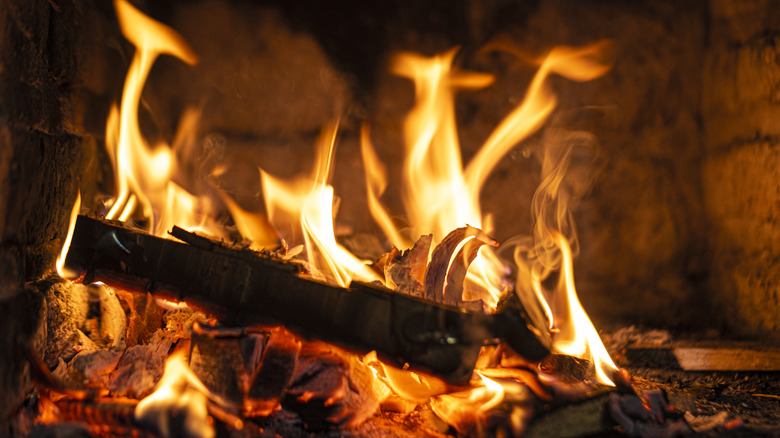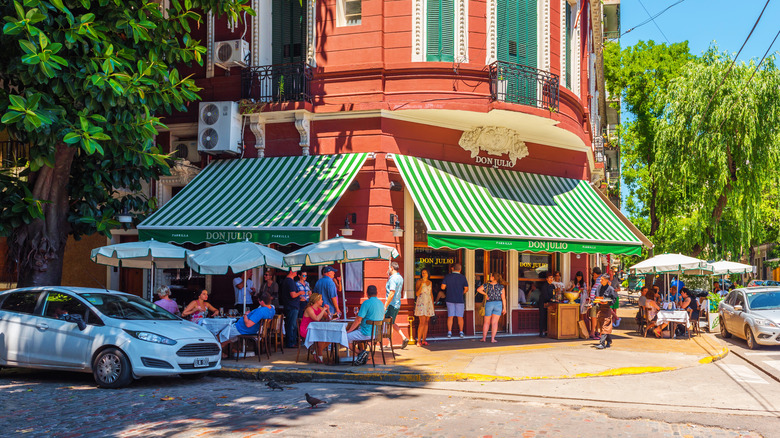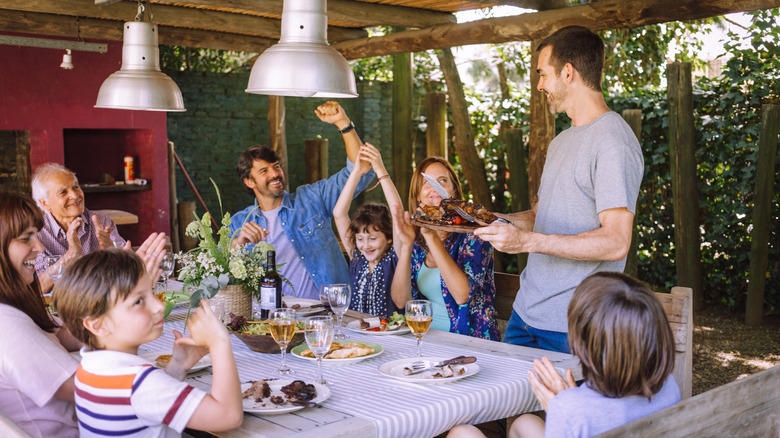11 Things To Know Before Trying Argentinian Asado
An Argentinian friend invites you to an asado, but you're wondering if there's anything special you need to know before going. And you're not sure if you'll need to follow certain rules. You might be thinking: Argentinians use forks and knives to eat barbecue, right? How long will this gathering last? What if you overstay your welcome? How much should you eat? Do you accept a second portion or politely refuse? If you don't already know, you'll do a little research and learn that asados are similar to barbecues — and you might ask yourself if there will be a vegetarian option? Should you get there early to help? Will the food be spicy?
There are answers to all of these legit questions, although perhaps not the ones you're expecting. Every culture has specific faux pas and codes that an outsider may or may not understand. Traditional (cultural) gatherings can be a fun experience, but they also come rife with opportunities to offend — so do some homework before heading to your first asado.
What does asado mean?
Asado means roasted and carne asada translates to roasted meat. In Argentina, the term takes on additional significance because it refers to a specific kind of gathering with family and friends as well as the food itself.
People from most cultures have been roasting meat over open fires since prehistory, so it may seem strange that this particular ritual would become a self-prescribed marker of identity for one group. Despite this, Argentina has claimed the asado as its definitive food, declaring asado part of its culinary patrimony. For Argentinians, getting together on holidays and weekends to share beef is at the front of their minds. There is no other meal that carries the same significance — think Thanksgiving in the United States, but if you had it a least once a month.
The food at an asado is important — it's almost always well-done beef, salted, but otherwise unseasoned and some Malbec wine to wash it down. The offerings are usually the same — some asados may include more side dishes, salads, or cuts of meat. More fundamentally, though, the shared company is what people love about an asado.
What's the difference between a bbq and an asado?
Meriam Webster defines barbeque as "a social gathering especially in the open air at which barbecued food is eaten." Buenos Aires's guide for tourists says asado is "a social ritual that brings friends and family together." These definitions sound similar, but the distinction is "ritual" indicating some inflexible aspects.
Barbeques can happen over an open fire or gas grill. Argentinians generally shun new-fangled cooking elements, preferring to prepare embers, burning charcoal or wood. Barbequers dowse meat with secret sauces, wowing guests with new flavor combinations. In Argentina, though, beef is simply seasoned with salt.
Throw anything on a grill and call it bbq. At an asado, grilled hot dogs, hamburgers, or vegetables could appear as alternatives for kids — but, most often, the meal is about a pound of beef per person — vacio (flank) or costillas (ribs), chorizo, and achuras (offal). An asado does not mean quickly searing steaks — it requires patience. If the cook uses wood, the embers take an hour to prepare, then the meat slowly roasts for another 70 to 90 minutes.
Finally, the role of the asador or griller is sacred. No one else touches the fire or grill — guests can serenade him on the guitar, get salads ready, or pour the wine, but grilling is a one-man game.
History of asado
In his explorations of the world with the H.M.S. Beagle in the 1830s, Charles Darwin stopped on the shores of Argentina and ate some asado. Officially, he was studying the geology of the region with his colleagues. They crossed the plains of La Pampa on horseback and when Darwin's party stopped at a seemingly humble adobe hut, the owner sent out his men to kill three head of semi-wild cattle from his enormous herd. For dinner, the host served the roasted meat in a bucket with only some boiled squash as a garnish.
Darwin felt surprised that a man with so many horses, cattle, and employees could live in such a precarious home. At the time, there were so many bovines in the country that owning them didn't necessarily equal wealth as it did in Darwin's home country of England.
What Darwin may not have known was that when the Spanish colonized the southern plains of South America a couple of centuries earlier, they brought cattle with them. The cattle escaped and thrived in Argentina's luscious grasslands, free of fences, growing into huge herds. At a time when the population was small, there was more beef than anyone could eat. This resulted in a population that had a taste for it and the logical consequence was a country of experts in roasting meat. Today, Argentina produces beef for export.
How much meat?
One fundamental rule of an asado is that there should be plenty of meat for every guest. Argentine cookbooks, newspapers, blogs and interviews with chefs pose the question often: How much meat do you need to buy for an asado? Of course, people in other countries ask the same question about making a pot roast or steaks, but the answer is usually less.
For example, the Roseville Meat Company has a meat calculator and recommends half a pound (8 ounces) of boneless meat or a pound of meat with the bone per person. For children, they suggest half that serving.
La Cronica, one of Argentina's largest newspapers, has more specific recommendations and suggests more abundant portions. They say just under a pound of boneless meat per man. Nearly 11 ounces per woman and 5 ounces per child. Then, to that, they add 7 ounces of chorizo and offal per person. The title of the article roughly translates to "Asado: How to calculate how much meat so that there's not too much or too little," but certainly seems to lean toward too much.
Cuts of meat
You eat asados course by course, but each one is a different cut or type of meat. An asado might last as long as a French dinner, but here you won't find soup, fish, or salad courses — just meat.
The sausages — chorizo and morcilla — are first. Chorizo is a traditional Spanish style while morcilla is made from blood. Often, chorizos are served as sandwiches. Next come the achuras or offal. This course could include mollejas (glands or sweetmeats), chinchulines (small intestine), and kidneys. When people finish eating these, the host may serve a bit of entraña (diaphragm or hanger steak) and matambre. Matambre is very thin and comes from the muscle between the ribs and skin. Its name means "hunger killer" because workers would eat this quick-cooking cut after the hard labor of butchering.
Entraña and matambre are meant to tide people over until the main course of costillas (ribs) and vacio (flank) come off the grill. These last two cuts will have roasted over a low fire for nearly two hours by the time they reach people's plates.
Not every asado includes every cut. A simpler gathering may consist of just chorizo and ribs or vacio which are the most fundamental parts.
What is chimichurri?
Usually, the asador (griller) just rubs meat with course salt before roasting it. If they do add another seasoning, though, it's usually chimichurri. Hosts also sometimes place this sauce on the table for their guests to use as they desire. It's the perfect dressing to give some extra kick to a chorizo sandwich.
Chimichurri is not spicy. It's a mix of oregano, dried sweet pepper flakes, chopped garlic, fresh parsley, oil, and vinegar. While some hosts may prepare it while the meat is on the grill, it's usually best if it sets overnight. That way the flavors can truly penetrate the oil. Since this mixture contains so much oil and vinegar, it can last a long time in the fridge without going bad. Just make sure all of it is submerged and use a paper towel to clean away any bits of parsley or garlic that stick to higher parts of the jar.
What is salsa criolla?
One of the most delicious salads you'll find at an asado is salsa criolla. The word criollo refers to foods, people, and traditions from Latin America, but of Spanish origin. In the case of this salad, Argentines call it criollo in the same way people from the United States might call a hamburger all-American. This sauce is similar to Mexican pico de gallo, but not spicy. Instead of jalapeños, salsa criolla calls for sweet bell peppers. The lime is replaced with vinegar and it doesn't include any cilantro.
The main ingredients of salsa criolla are equal parts of finely chopped onion, tomato, and bell peppers. The peppers can be red, green or yellow, but the most beautiful salad includes all three. Use a combination of red onion, white onion, and green onion to add color and flavor as well. Finally pour in the oil and vinegar in a proportion of three to one. Let it set for an hour for the best results.
Scoop a bit of salsa criolla onto a forkful of meat for full effect or ladle it over your choripán (chorizo sandwich) for an explosive mouthful of flavor. If all else fails, dip your bread in or just eat it by the spoonful.
The fire
Since Argentinians usually prefer a wood fire to make asado, they have some fantastic hacks for lighting it and producing plenty of red-hot embers for cooking.
For example, to start the blaze, Buenos Aires Tourism recommends using the "volcano method." Twist the two pages of newspaper into rings around the bottom of your bottle of Malbec. Then place vertical twigs around it. Finally, add small firewood in the same direction. Slowly pull the bottle out of the center and put a match in the hole in the center.
Then, the best asadors have a place for the grill and next to it, an area for the fire. It takes around an hour for firewood to burn down to embers for cooking, and running out of embers is an unforgivable mistake on the part of the asador. That's why you'll usually see a fire burning on one side which will provide fresh, hot embers throughout the entire affair. The asador uses a little shovel to spread the embers under the grill, leaving one side low heat with fewer embers to slowly roast the vacio and costillas — while the side nearer the fire is hotter and perfect for chorizo and thinner cuts like entraña and matambre.
Where can I try asado?
Asado is a carnivore's dream come true and you want to try one, but if you don't have any Argentinian friends to invite you and aren't sure about getting the fire going in your own backyard, you could plan a trip to Buenos Aires! That's the best way to try an authentic asado. Make a reservation at Parrilla Don Julio, an award-winning restaurant listed as one of the world's 50 best and considered one of the best grills in Argentina. Of course, if you're hoping for a more rural experience, you could go on an estancia tour, like those offered by a company called Camino Pampa. These offer a chance to see a historic cattle ranch, have contact with horses, and try an asado.
If time, money, or health restrict your travel, there are some ways to try an asado closer to home. There are restaurants in the United States that offer Argentinian asado, among them is Buenos Aires, a New York restaurant. On the other hand, you could bring the asado and asador to your backyard. Just google asado catering and you'll find companies like Asados at Home, and The Gauchos Catering in most states. These are services offered by expat Argentinians. They'll come to your home, set up an asado in your backyard, and serve you one of the most delicious meals of your life.
Asado is more than just food
Most Argentinians would tell you it's more about the gathering than the food. People get together to eat asados with their families and friends because they want to share the day, and because they want some beef.
This social aspect of asados caught ESPN's attention because these gatherings have had an impact on Major League Soccer. Argentina exports a huge number of soccer players and coaches to this league and they took their asados with them. Now, teams across the country — Orlando, Cincinnatti, and San Jose — get together to chow down on roasted meat prepared by their Argentinian players and coaches. It brings the athletes closer together and makes for better team cohesion.
Think of this as just a small example of the wider role asados play in Argentina as a whole. There, friends, families, sports teams, yoga classes, schools, and whole towns gather to partake in asados together. If you belong to any kind of group in the South American country, you won't have to wait long until it organizes an asado for all the members.
Etiquette for an asado
At the most informal asados, gauchos (Argentinian cowboys) are expected to bring their own knives called facons. Then, they all stand or squat around the fire chatting. They grab a piece of bread, rip it open, and when the meat is ready, cut off a bit to make a sandwich. At these gatherings there are no chairs, tables, plates, or silverware. On the other end of the spectrum, you could find yourself sitting at a table on a beautifully manicured lawn, under the shade of a huge tree. The host serves you the best Argentinian Malbec wine in crystal glasses, and there are gorgeous wooden plates for each person. Despite the elegance, this asado is laid-back so everyone feels comfortable.
Asados are casual events, so no one's likely to be offended if you pick up a rib with your fingers and nibble on it — although look around first and take your cue from the group. People will reach across you at the table to grab what they need. Napkins don't always go on laps — Argentinians usually leave them on the table. You may even see people talking while chewing food! You probably won't offend anyone with poor table manners, but don't touch the grill or cooking meat. It may be tempting to get involved, but the asador will perceive this as rude. Finally, clap for the asador when one of your fellow diners says: "un aplauso para el asador" meaning "clap for the cook."
